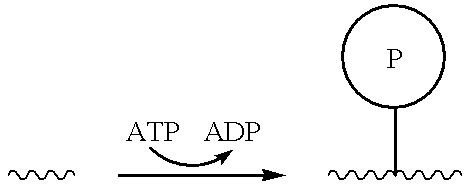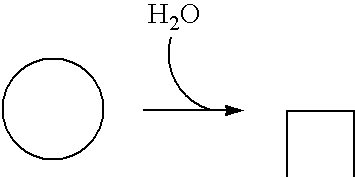Molecular modification assays
a molecular modification and assay technology, applied in the field of molecular modification assays, can solve the problems of short-term safety hazards for the assay operator, long-term storage and disposal problems, and inability to obtain suitable antibodies for many substrates and kinases, and achieve the effects of decreasing rotational mobility and increasing luminescence polarization of the protein
- Summary
- Abstract
- Description
- Claims
- Application Information
AI Technical Summary
Benefits of technology
Problems solved by technology
Method used
Image
Examples
example 1
[0084]This example describes a macromolecular trapping system for use in luminescence polarization and / or energy transfer assays, among others, in accordance with aspects of the invention. In this system, Ru2+ is entrapped in small (˜20-30 kDa) synthetic polymer macromolecules (MM), which are obtained from PreSens Precision Sensing (Neuburg / Donau, Germany). These macromolecules are relatively hydrophilic, with carboxyl groups on their surfaces for activation. The MM with the entrapped Ru2+ is used as a support to immobilize tricationic metal cations, including Fe3+ and Ga3+. Specifically, the chelator imidodiacetic (IDA) acid is linked to the MM using the secondary amine group of IDA and a carboxyl group on the MM. Afterwards, the MM-IDA is incubated with either FeCl3 or GaCl3. The FeCl3 quenches the luminescence of Ru2+, whereas the GaCl3 does not. The macromolecule loaded with Fe3+ or Ga3+ is denoted MM-Fe or MM-Ga, respectively.
example 2
[0088]This example describes assays for the presence, activity, substrates, and / or products of kinases in accordance with aspects of the invention. Similar assays may be used to analyze phosphatases in which the substrates and products of the kinase reaction become the products and substrates of the phosphatase reaction, respectively.
[0089]Kinases catalyze the addition of phosphate groups to appropriate substrates, as shown below:
Thus, the presence and / or activity of a kinase may be detected by a decrease in the concentration of a nonphosphorylated (e.g., polypeptide) substrate and / or by an increase in the concentration of a corresponding phosphorylated product, among others. (The presence and / or activity of a phosphatase may be detected similarly by a decrease in the concentration of a phosphorylated substrate and / or an increase in the concentration of a nonphosphorylated product.) The invention provides among others kinase assays that involve contacting a sample containing a cand...
example 3
[0090]This example describes experiments to characterize binding between MM-Ga and a fluorescein-labeled di-phosphotyrosine 15-amino-acid peptide tracer denoted tyrosine kinase 1 (TK-1) tracer. These experiments show the utility of the MM-Ga system for detection of phosphorylated tyrosine and the presence and / or activity of tyrosine kinases and phosphatases.
[0091]FIG. 8 shows the effects of incubating 10 nM TK-1 tracer with different concentrations of MM-GA (total volume=50 μL; incubation time=60 min). These experiments show that the maximum polarization change is more than 200 mP, at least when the MM-Ga and TK-1 tracer are incubated in MES buffer (0.1M MES, pH 5.5, 1.0 M NaCl). This polarization change is at least sufficient for most polarization assays.
[0092]FIG. 9 shows a dose-response curve for TK-1 calibrator, with 10 nM TK-1 tracer and 1.6 nM (estimated) MM-Ga. The TK-1 calibrator is the same as the TK-1 tracer, without a fluorescein label. The bound / total ratio is calculated...
PUM
| Property | Measurement | Unit |
|---|---|---|
| volumes | aaaaa | aaaaa |
| pH | aaaaa | aaaaa |
| pH | aaaaa | aaaaa |
Abstract
Description
Claims
Application Information
 Login to View More
Login to View More - R&D
- Intellectual Property
- Life Sciences
- Materials
- Tech Scout
- Unparalleled Data Quality
- Higher Quality Content
- 60% Fewer Hallucinations
Browse by: Latest US Patents, China's latest patents, Technical Efficacy Thesaurus, Application Domain, Technology Topic, Popular Technical Reports.
© 2025 PatSnap. All rights reserved.Legal|Privacy policy|Modern Slavery Act Transparency Statement|Sitemap|About US| Contact US: help@patsnap.com



